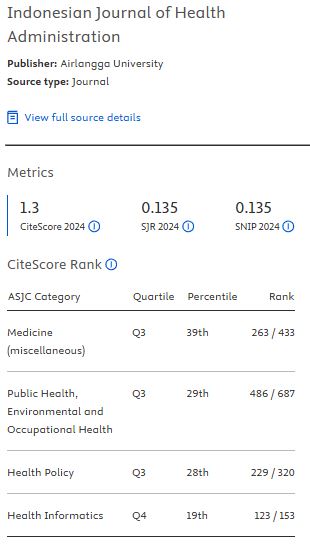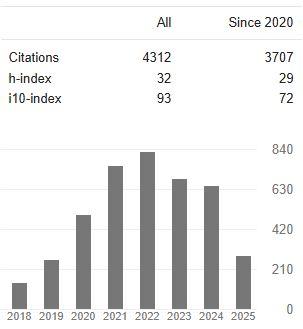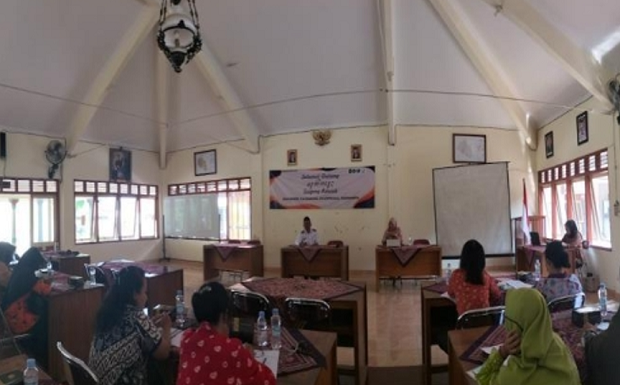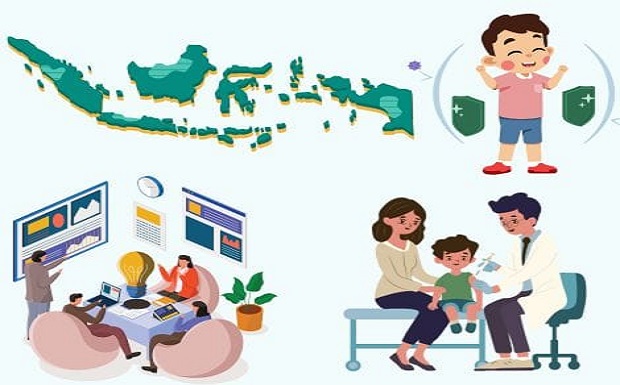IMPLEMENTATION OF THEORY OF CONSTRAINT ON WAITING TIME OF PRESCRIPTION SERVICE
Downloads
Background: Medical services provided within the Indonesian National Health Insurance programme or Jaminan Kesehatan Nasional (JKN) have been continuously improving for the past several years. One of them is pharmaceutical service in the Pharmacy Store for JKN patients at one hospital with the highest number of visitors in Surabaya. However, one preliminary study points out that patient waiting time for prescription services in the Pharmacy Store for JKN patients is longer than the national standard.
Aim: This study aims to investigate the causes for such delay in prescription services as one of pharmaceutical services in the Pharmacy Store for JKN patients at one hospital in Surabaya.
Methods: This is an observational descriptive research with a reference to the Theory of Constraints. The research was conducted from August 2017 to February 2018. The data were obtained from observations, interviews with one pharmacist and four pharmacy technicians, and waiting time for prescription service.
Results: The study finds that the longer waiting time is caused by inefficient division of jobs and workers and the lack of worker's discipline to work on time. The behaviors and habits of pharmacist and pharmacy technicians in drug preparation greatly affect patient waiting time, since the services still highly depend on manual human labor.
Conclusions: Patient experience in prescription drug services is significantly influenced by the time spent waiting for the service provider. This studyprovides useful insights about constraint identification in pharmaceutical services, especially waiting time.
Keywords: Pharmaceutical service, Theory of Constraints, Patient waiting time.
Astuti, H. (2017) ‘Evaluasi Waktu Tunggu Pelayanan Resep di Puskesmas Kalibawang Kabupaten Kulon Progo Daerah Istimewa Yogyakarta Bulan Februari 2017', AKFARINDO, 2(2), pp. 26–30.
Azwar, H. (2015) Pengaruh Disiplin Kerja Terhadap Kinerja Karyawan di Hotel Grand Inna Muara Padang. Undergraduate Thesis. Universitas Negeri Padang.
Barrick, me. J. (2009) Transforming Health Care Management: Integrating Technology Strategies: Integrating Technology Strategies.
Sundburry: Jones & Bartlett Learning. Basuki (2016) Metode Penelitian Akuntansi dan Manajemen Berbasis Studi Kasus. 1st edn. Airlangga Universitty Press.
Manajemen_Berbasis_Studi_Kasus/stats. Bhattacharjee, P. and Ray, P. K. (2014) ‘Patient flow modelling and performance analysis of healthcare delivery processes in hospitals: A review and reflections', Computers & Industrial Engineering, 78, pp. 299–312.
Brinkmann, S. (2014) ‘Interview', in Teo, T. (ed.)Encyclopedia of Critical Psychology. New York, NY: Springer New York, pp. 1008–1010.
Centers for Desease Control and Preventation (2008) ‘Data Collection Methods for Program Evaluation: Observation', eTA Evaluation Briefs, (16).
Cope, D. G. (2014) ‘Methods and Meanings: Credibility and Trustworthiness of Qualitative Research', Oncology Nursing Forum, 41(1), pp. 89–91.
Desselle, S. P. and Zgarrick, D. P. (2009) Pharmacy Management : Essentials for All Practice Settings. 2nd edn. New York: McGraw-Hill.
Dila, A. N. and Rochmah, T. N. (2015) ‘Analisis Pengaruh Komunikasi, Kepemimpinan, dan Tim Kerja Terhadap Kedisiplinan Pegawai Rumah Sakit X Surabaya', Jurnal Administrasi Kesehatan Indonesia, 3(2), pp. 129–138.
Fitriah, N., Faramita, N. me. and Wiyanto, S. (2016) ‘Penyebab dan Solusi Lama Waktu Tunggu Pelayanan Obat di Instalasi Farmasi Rawat Jalan Rumah Sakit', jurnal Kedokteran Brawijaya, 29(3), pp. 245–251.
Griffin, D. J. (2012) Hospital: What They Are and How They Work. 4th edn. San Marcos: Jones and Bratlet Learning.
Gupta, M. and Kline, J. (2008) ‘Managing a community mental health agency: A Theory of Constraints based framework', Total Quality Management & Business Excellence. Routledge, 19(3), pp. 281–294.
Hansen, D. R., Mowen, M. M. and Guan, L. (2009) Cost Management: Accounting & Control. 6th edn. Mason: South Western Cengage Learning.
Hardiyanti, R. (2017) ‘Pengaruh Pembagian Kerja dan Pengawasan terhadap Efektivitas Kerja Pegawai di Kantor Kecamatan Sangatta Utara Kabupaten Kutai Timur', e-journal Pemerintah Integratif, 5(4), pp. 570–580.
Herjunianto, Wardhani, V. and Prihastuty, J. (2014) ‘Faktor yang Mempengaruhi Cakupan Layanan Farmasi di Instalasi Rawat Jalan, Jurnal Kedokteran Brawijaya, 28(1), pp. 8–14.
Karuniawati, H. et al. (2016) ‘Evaluasi Pelaksanaan Standar Pelayanan Minimal (SPM) Farmasi Kategori Lama Waktu Tunggu Pelayanan Resep Pasien Rawat Jalan di RSUD Kota Salatiga', Kartika-Jurnal Ilmiah Farmasi, 4(1), pp. 20–25.
Kim, E. et al. (2013) ‘Discovery of Outpatient Care Process of a Tertiary University Hospital Using Process Mining', Healthc Inform Res. The Korean Society of Medical Informatics, 19(1), pp. 42–49.
Kim, S., Mabin, V. J. and Davies, J. (2008) ‘The theory of constraints thinking processes : retrospect and prospect', International Journal of Operations & Production Management, 28(2), pp. 155–184.
Lakshmi, C. and Sivakumar, A. me. (2013) ‘Application of queueing theory in health care: A literature review', Operations Research for Health Care, 2(1), pp. 25–39.
Liang, B. et al. (2015) ‘Improvement of chemotherapy patient flow and scheduling in an outpatient oncology clinic', International Journal of Production Research. Taylor & Francis, 53(24), pp. 7177–7190.
Loh, B. C. et al. (2017) ‘Impact of Value Added Services on Patient Waiting Time at the Ambulatory Pharmacy Queen Elizabeth Hospital', Pharmacy Practice, 15(1), pp. 1–7.
Management Sciences for Health (2012) MDS-3: Managing Access to Medicines and Health Technologies. Edited by M. Embrey. Arlington, VA: Management Sciences for Health.
Margiluruswati, P. and Irmawati, L. me. (2017) ‘Analisis Ketepatan Waktu Tunggu Pelayanan Resep Pasien JKN dengan Standar Pelayanan Minimal Rumah Sakit 2017 (Studi di UPF Rawat Jalan RSUD Bhakti Dharma Husada)', Jurnal Manajemen Kesehatan Yayasan RS. Dr. Soetomo, 3(1), pp. 115–126.
Ministry of Health of Republic Indonesia (2008) Standar Pelayanan Minimal Rumah Sakit. Indonesia.
Nassaji, H. (2015) ‘Qualitative and descriptive research: Data type versus data analysis', Language Teaching Research, 19(2), pp. 129–132.
Niu, Q., Peng, Q. and ElMekkawy, T. Y. (2013) ‘Improvement in the Operating Room Efficiency using Tabu Search in Simulation', Business Process Management Journal, 19(5), pp. 799–818.
Purwanto, H. et al. (2015) ‘Faktor Penyebab Waktu Tunggu Lama di Pelayanan Instalasi Farmasi Rawat Jalan RSUD Blambangan', Jurnal Kedokteran Brawijaya, 28(2), pp. 159-162.
Rahmawati, me. N. and Wahyuningsih, S. S. (2016) ‘Faktor Pelayanan Kefarmasian dalam Peningkatan Kepuasan Pasien di Pelayanan Kesehatan', Indonesian Journal on medical Science, 3(1), pp. 88–95.
Rizanti, H. E. (2012) Analisis Faktor Penyebab Lama Waktu Tunggu Pelayanan Resep di Unit Farmasi Rawat Jalan Rumah Sakit PHC Surabaya. Undergraduate Thesis.Universitas Airlangga.
Ronen, B., Pliskin, J. S. and Pass, S. (2018) The Hospital and Clinic Improvement Handbook:Using Lean and the Theory of Constraints for Better Healthcare Delivery. New York: Oxford University Press.
Siagian, S. P. (2014) Manajemen Sumber Daya Manusia. Jakarta: Bumi Aksara.
Åžimşit, Z. T., Günay, N. S. and Vayvay, Ö. (2014)‘Theory of Constraints: A Literature Review',Procedia - Social and Behavioral Sciences,150(231), pp. 930–936.
Susanty, A. and Baskoro, S. W. (2013) ‘Pengaruh Motivasi Kerja dan Gaya Kepemimpinan Terhadap Disiplin Kerja Serta Dampaknya Pada Kinerja Karyawan (Studi Kasus Pada PT. PLN (Persero) APD Semarang)', J@tii Undip: Jurnal Teknik Industri, 7(2), pp. 77–84.
Woeppel, M. (2001) Manufacturer's Guide to Implementing the Theory of Constraints. Boca Raton: CRC Press LLC.
Zhao, Y. et al. (2015) ‘Bottleneck detection for improvement of Emergency Department efficiency', Business Process Management Journal, 21(3), pp. 564–585.
1. As an author you (or your employer or institution) may do the following:
- make copies (print or electronic) of the article for your own personal use, including for your own classroom teaching use;
- make copies and distribute such copies (including through e-mail) of the article to research colleagues, for the personal use by such colleagues (but not commercially or systematically, e.g. via an e-mail list or list server);
- present the article at a meeting or conference and to distribute copies of the article to the delegates attending such meeting;
- for your employer, if the article is a ‘work for hire', made within the scope of your employment, your employer may use all or part of the information in the article for other intra-company use (e.g. training);
- retain patent and trademark rights and rights to any process, procedure, or article of manufacture described in the article;
- include the article in full or in part in a thesis or dissertation (provided that this is not to be published commercially);
- use the article or any part thereof in a printed compilation of your works, such as collected writings or lecture notes (subsequent to publication of the article in the journal); and prepare other derivative works, to extend the article into book-length form, or to otherwise re-use portions or excerpts in other works, with full acknowledgement of its original publication in the journal;
- may reproduce or authorize others to reproduce the article, material extracted from the article, or derivative works for the author's personal use or for company use, provided that the source and the copyright notice are indicated.
All copies, print or electronic, or other use of the paper or article must include the appropriate bibliographic citation for the article's publication in the journal.
2. Requests from third parties
Although authors are permitted to re-use all or portions of the article in other works, this does not include granting third-party requests for reprinting, republishing, or other types of re-use.
3. Author Online Use
- Personal Servers. Authors and/or their employers shall have the right to post the accepted version of articles pre-print version of the article, or revised personal version of the final text of the article (to reflect changes made in the peer review and editing process) on their own personal servers or the servers of their institutions or employers without permission from JAKI;
- Classroom or Internal Training Use. An author is expressly permitted to post any portion of the accepted version of his/her own articles on the author's personal web site or the servers of the author's institution or company in connection with the author's teaching, training, or work responsibilities, provided that the appropriate copyright, credit, and reuse notices appear prominently with the posted material. Examples of permitted uses are lecture materials, course packs, e-reserves, conference presentations, or in-house training courses;























